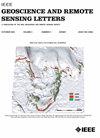Disk-Shaped Random Scatterers With Application to Model-Based PolSAR Decomposition
IF 4
3区 地球科学
Q2 ENGINEERING, ELECTRICAL & ELECTRONIC
引用次数: 6
Abstract
Polarimetric SAR (PolSAR) imagery offers an enhanced capability to reveal the salient scattering properties of scene content. PolSAR-based target decomposition has been widely used to show different apparent scattering mechanisms for various target classes, empowering a direct yet powerful technique for SAR imagery analysis. Among those common targets, modeling the random volume scattering from vegetation is one of the most important. Generally, one models vegetation as a cloud of randomly oriented thin cylinders, mainly intended for twigs and branches. At high radar frequencies, PolSAR imagery shows a strong response from leaves in the vegetation canopy. In this letter, we derive the polarimetric scattering theory for general random volume scatterers, including both thin cylinders and thin disks as limiting cases for leaf response. Adding the proposed random thin disk model explains the observed scattering difference between deciduous forest and coniferous forest, which we then incorporate into a new model-based PolSAR target decomposition scheme.圆盘形随机散射体及其在基于模型的PolSAR分解中的应用
极化SAR(PolSAR)图像提供了一种增强的能力来揭示场景内容的显著散射特性。基于PolSAR的目标分解已被广泛用于显示不同目标类别的不同表观散射机制,为SAR图像分析提供了一种直接而强大的技术。在这些常见的目标中,植被的随机体积散射建模是最重要的目标之一。通常,人们将植被建模为一团随机定向的薄圆柱体,主要用于树枝和树枝。在高雷达频率下,PolSAR图像显示植被冠层中的树叶有强烈的响应。在这封信中,我们推导了一般随机体积散射体的极化散射理论,包括薄圆柱体和薄圆盘作为叶响应的极限情况。添加所提出的随机薄板模型解释了落叶林和针叶林之间观测到的散射差异,然后我们将其纳入一个新的基于模型的PolSAR目标分解方案中。
本文章由计算机程序翻译,如有差异,请以英文原文为准。
求助全文
约1分钟内获得全文
求助全文
来源期刊

IEEE Geoscience and Remote Sensing Letters
工程技术-地球化学与地球物理
CiteScore
7.60
自引率
12.50%
发文量
1113
审稿时长
3.4 months
期刊介绍:
IEEE Geoscience and Remote Sensing Letters (GRSL) is a monthly publication for short papers (maximum length 5 pages) addressing new ideas and formative concepts in remote sensing as well as important new and timely results and concepts. Papers should relate to the theory, concepts and techniques of science and engineering as applied to sensing the earth, oceans, atmosphere, and space, and the processing, interpretation, and dissemination of this information. The technical content of papers must be both new and significant. Experimental data must be complete and include sufficient description of experimental apparatus, methods, and relevant experimental conditions. GRSL encourages the incorporation of "extended objects" or "multimedia" such as animations to enhance the shorter papers.
 求助内容:
求助内容: 应助结果提醒方式:
应助结果提醒方式:


